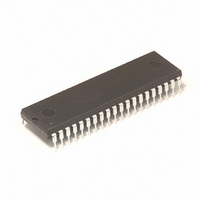MC908GP32CPE Freescale Semiconductor, MC908GP32CPE Datasheet - Page 187

MC908GP32CPE
Manufacturer Part Number
MC908GP32CPE
Description
IC MCU 8MHZ 32K FLASH 40-DIP
Manufacturer
Freescale Semiconductor
Series
HC08r
Datasheet
1.MC908GP32CFBE.pdf
(266 pages)
Specifications of MC908GP32CPE
Core Processor
HC08
Core Size
8-Bit
Speed
8MHz
Connectivity
SCI, SPI
Peripherals
LVD, POR, PWM
Number Of I /o
33
Program Memory Size
32KB (32K x 8)
Program Memory Type
FLASH
Ram Size
512 x 8
Voltage - Supply (vcc/vdd)
2.7 V ~ 5.5 V
Data Converters
A/D 8x8b
Oscillator Type
Internal
Operating Temperature
-40°C ~ 85°C
Package / Case
40-DIP (0.600", 15.24mm)
Processor Series
HC08GP
Core
HC08
Data Bus Width
8 bit
Data Ram Size
512 B
Interface Type
SCI, SPI
Maximum Clock Frequency
8 MHz
Number Of Programmable I/os
33
Number Of Timers
4
Maximum Operating Temperature
+ 85 C
Mounting Style
Through Hole
Development Tools By Supplier
FSICEBASE, DEMO908GZ60E, M68CBL05CE, M68EML08GPGTE
Minimum Operating Temperature
- 40 C
On-chip Adc
8 bit, 8 Channel
Lead Free Status / RoHS Status
Lead free / RoHS Compliant
Eeprom Size
-
Lead Free Status / Rohs Status
Details
Available stocks
Company
Part Number
Manufacturer
Quantity
Price
Company:
Part Number:
MC908GP32CPE
Manufacturer:
NXP
Quantity:
9 282
Part Number:
MC908GP32CPE
Manufacturer:
FREESCALE
Quantity:
20 000
- Current page: 187 of 266
- Download datasheet (3Mb)
15.9 Resetting the SPI
Any system reset completely resets the SPI. Partial resets occur whenever the SPI enable bit (SPE) is
low. Whenever SPE is low, the following occurs:
These items are reset only by a system reset:
By not resetting the control bits when SPE is low, the user can clear SPE between transmissions without
having to set all control bits again when SPE is set back high for the next transmission.
By not resetting the SPRF, OVRF, and MODF flags, the user can still service these interrupts after the
SPI has been disabled. The user can disable the SPI by writing 0 to the SPE bit. The SPI can also be
disabled by a mode fault occurring in an SPI that was configured as a master with the MODFEN bit set.
15.10 Low-Power Modes
The WAIT and STOP instructions put the MCU in low power-consumption standby modes.
15.10.1 Wait Mode
The SPI module remains active after the execution of a WAIT instruction. In wait mode the SPI module
registers are not accessible by the CPU. Any enabled CPU interrupt request from the SPI module can
bring the MCU out of wait mode.
If SPI module functions are not required during wait mode, reduce power consumption by disabling the
SPI module before executing the WAIT instruction.
To exit wait mode when an overflow condition occurs, enable the OVRF bit to generate CPU interrupt
requests by setting the error interrupt enable bit (ERRIE). (See
15.10.2 Stop Mode
The SPI module is inactive after the execution of a STOP instruction. The STOP instruction does not
affect register conditions. SPI operation resumes after an external interrupt. If stop mode is exited by
reset, any transfer in progress is aborted, and the SPI is reset.
15.11 SPI During Break Interrupts
The system integration module (SIM) controls whether status bits in other modules can be cleared during
the break state. The BCFE bit in the SIM break flag control register (SBFCR) enables software to clear
status bits during the break state. (See
Freescale Semiconductor
•
•
•
•
•
•
•
•
The SPTE flag is set.
Any transmission currently in progress is aborted.
The shift register is cleared.
The SPI state counter is cleared, making it ready for a new complete transmission.
All the SPI port logic is defaulted back to being general-purpose I/O.
All control bits in the SPCR register
All control bits in the SPSCR register (MODFEN, ERRIE, SPR1, and SPR0)
The status flags SPRF, OVRF, and MODF
MC68HC908GP32 Data Sheet, Rev. 10
Chapter 14 System Integration Module
15.8
Interrupts.)
(SIM).)
Resetting the SPI
187
Related parts for MC908GP32CPE
Image
Part Number
Description
Manufacturer
Datasheet
Request
R
Part Number:
Description:
Manufacturer:
Freescale Semiconductor, Inc
Datasheet:
Part Number:
Description:
Manufacturer:
Freescale Semiconductor, Inc
Datasheet:
Part Number:
Description:
Manufacturer:
Freescale Semiconductor, Inc
Datasheet:
Part Number:
Description:
Manufacturer:
Freescale Semiconductor, Inc
Datasheet:
Part Number:
Description:
Manufacturer:
Freescale Semiconductor, Inc
Datasheet:
Part Number:
Description:
Manufacturer:
Freescale Semiconductor, Inc
Datasheet:
Part Number:
Description:
Manufacturer:
Freescale Semiconductor, Inc
Datasheet:
Part Number:
Description:
Manufacturer:
Freescale Semiconductor, Inc
Datasheet:
Part Number:
Description:
Manufacturer:
Freescale Semiconductor, Inc
Datasheet:
Part Number:
Description:
Manufacturer:
Freescale Semiconductor, Inc
Datasheet:
Part Number:
Description:
Manufacturer:
Freescale Semiconductor, Inc
Datasheet:
Part Number:
Description:
Manufacturer:
Freescale Semiconductor, Inc
Datasheet:
Part Number:
Description:
Manufacturer:
Freescale Semiconductor, Inc
Datasheet:
Part Number:
Description:
Manufacturer:
Freescale Semiconductor, Inc
Datasheet:
Part Number:
Description:
Manufacturer:
Freescale Semiconductor, Inc
Datasheet:











